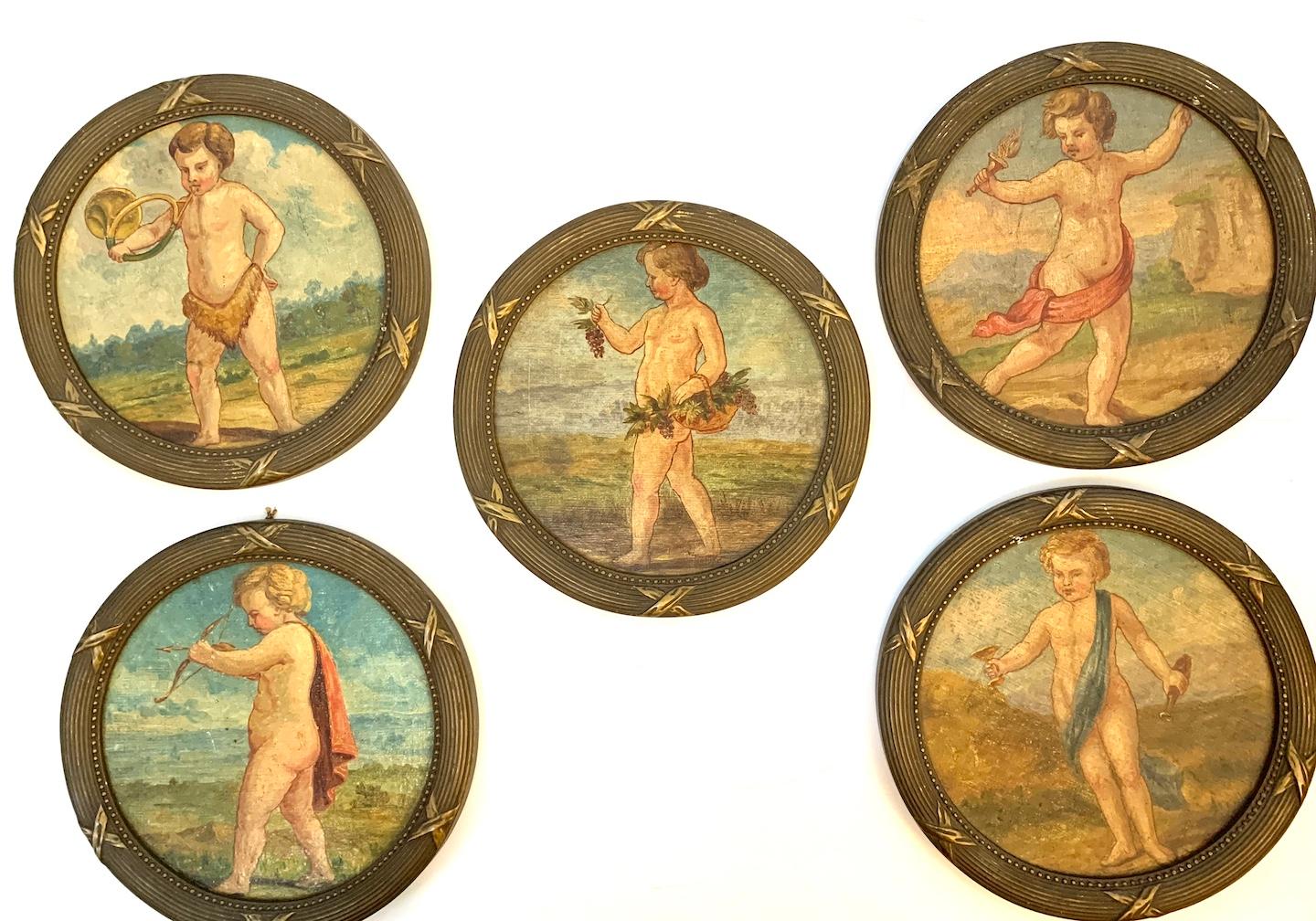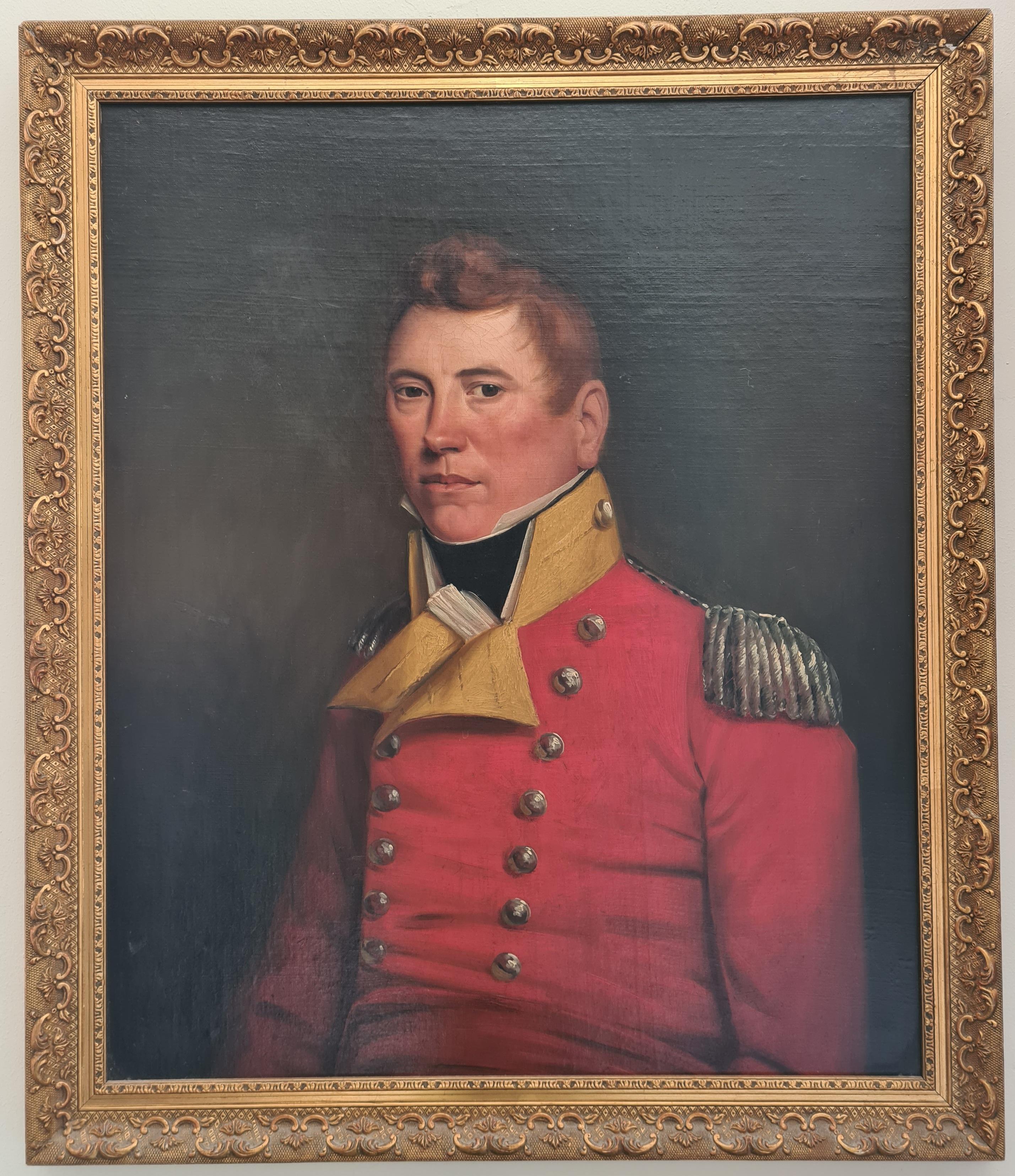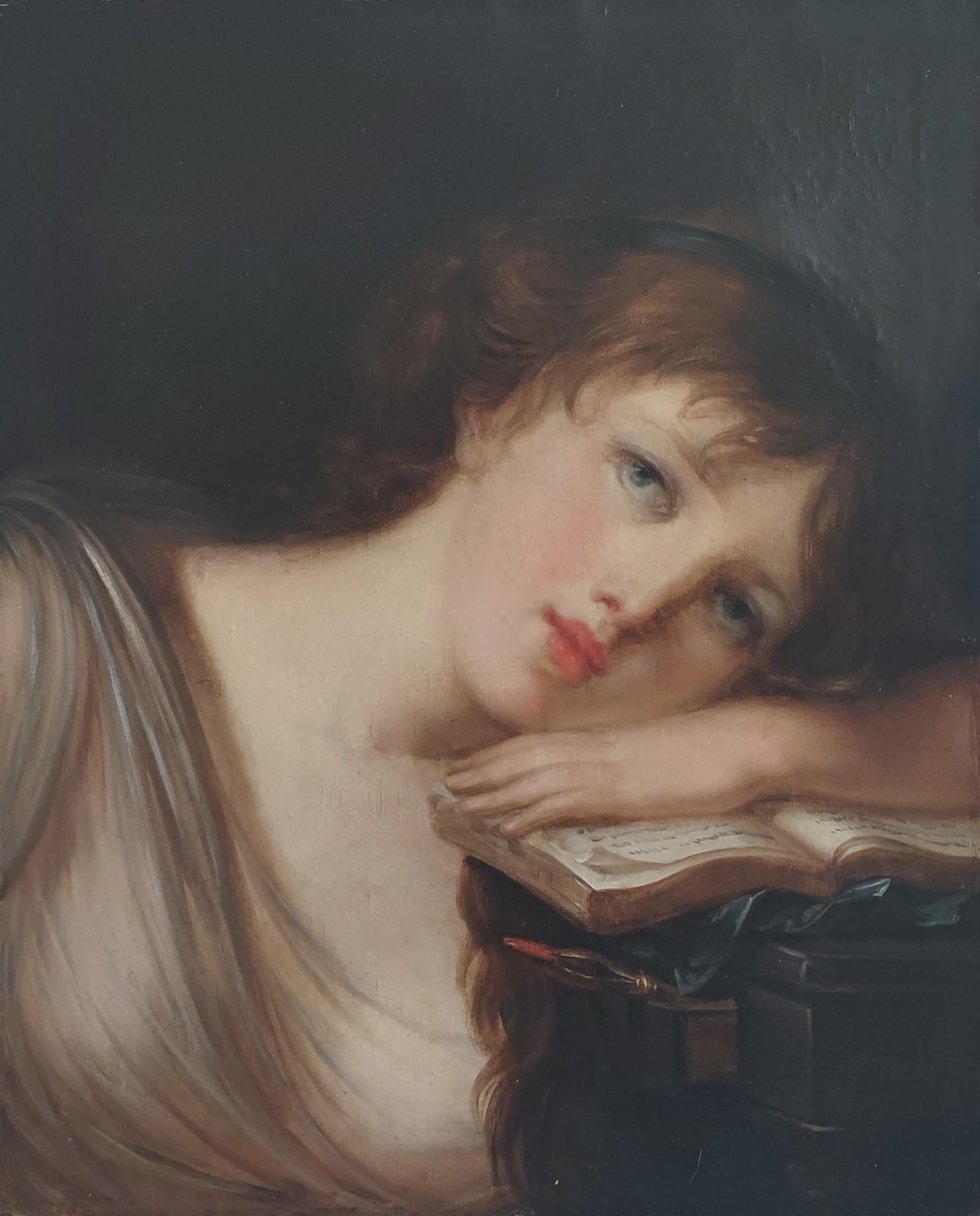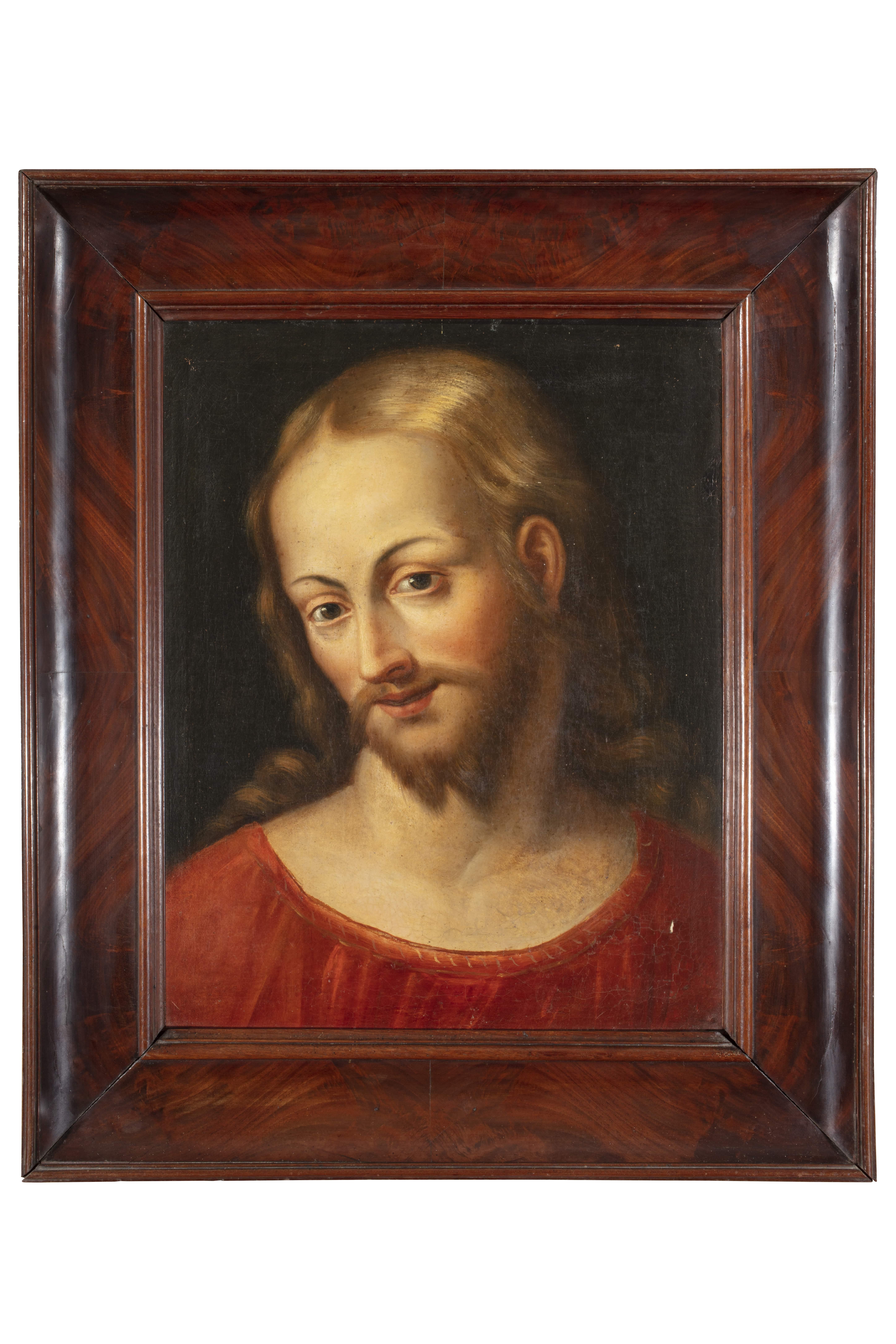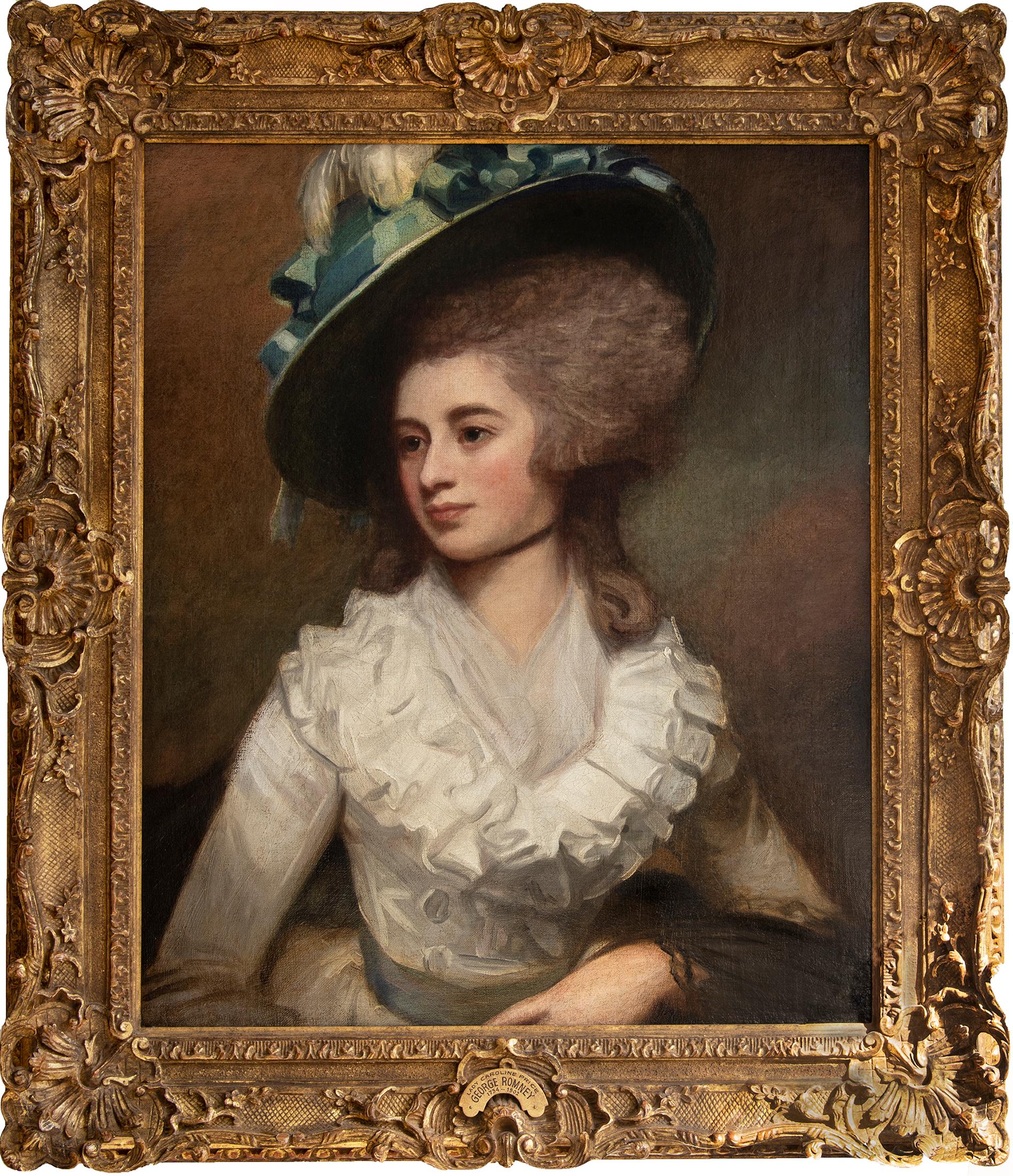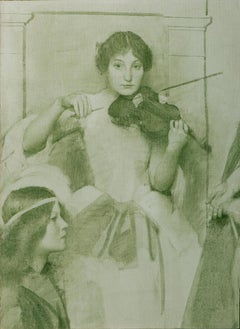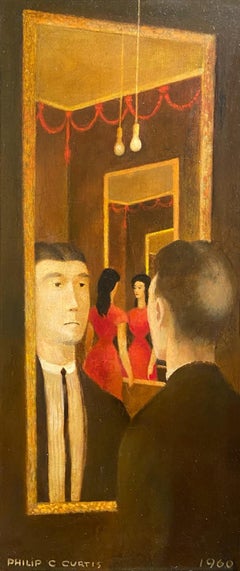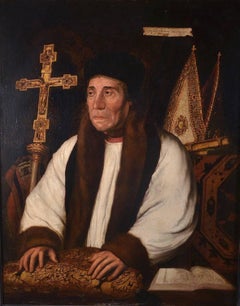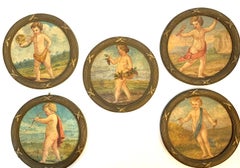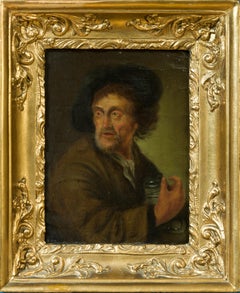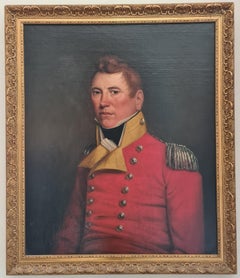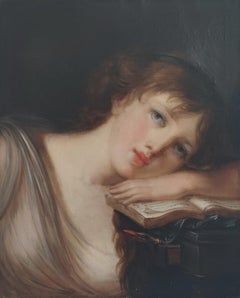Items Similar to Soldier in an Interior, Early 17th Century Dutch Oil
Want more images or videos?
Request additional images or videos from the seller
1 of 10
Pieter Symonsz PotterSoldier in an Interior, Early 17th Century Dutch Oil1600-1650
1600-1650
About the Item
Pieter Symonsz Potter
Dutch 1600 - 1652
Soldier in an Interior
Oil on oak panel, red seal to reverse
Image size: 15 x 10 3/4 inches
Dutch Ebonised frame
Bathed in a well lit room, a man stands with his trusty dog in front of a map. His clothes – he is wearing boots with spurs, elegant outfit and a sword – suggest that he is a soldier. The map suggests he has travelled for his fighting and the spartan room.
The man holds a miniature portrait of a lady, so more than likely his wife who has passed away. Like most of Potter's soldier scenes this picture is most likely to be painted in Amsterdam in the 1630s.
Pieter Symonsz Potter
Pieter Symonsz Potter (1597, Enkhuizen – 1652, Amsterdam), was a Dutch Golden Age painter. According to Houbraken he was the city secretary of Enkhuizen, married to the daughter of Paulus Bertius and the father of the painter Pieter I Potter, making him the grandfather of Pieter II, Paulus, and Maria Potter. His wife was the sister of the painter Willem Bartsius, and he was the father, not the grandfather, of Pieter II, Paulus and Maria. He was first trained as a glass painter and in 1628 moved to Leiden to learn painting in oils. He is known mostly for genre pieces and farm landscapes, and he became a member of the Delft Guild of St. Luke in 1646, and a member of the Confrerie Pictura in 1647 (though this record in the The Hague guild archives may have been for drawing lessons for his oldest son Peter).
- Creator:Pieter Symonsz Potter (1600 - 1652, Dutch)
- Creation Year:1600-1650
- Dimensions:Height: 15 in (38.1 cm)Width: 10.75 in (27.31 cm)
- More Editions & Sizes:1 of 1Price: $10,184
- Medium:
- Movement & Style:
- Period:Early 17th Century
- Condition:Slight curve to panel.
- Gallery Location:London, GB
- Reference Number:1stDibs: LU52412883112
About the Seller
5.0
Gold Seller
Premium sellers maintaining a 4.3+ rating and 24-hour response times
Established in 2007
1stDibs seller since 2014
80 sales on 1stDibs
Typical response time: 5 hours
- ShippingRetrieving quote...Shipping from: London, United Kingdom
- Return Policy
Authenticity Guarantee
In the unlikely event there’s an issue with an item’s authenticity, contact us within 1 year for a full refund. DetailsMoney-Back Guarantee
If your item is not as described, is damaged in transit, or does not arrive, contact us within 7 days for a full refund. Details24-Hour Cancellation
You have a 24-hour grace period in which to reconsider your purchase, with no questions asked.Vetted Professional Sellers
Our world-class sellers must adhere to strict standards for service and quality, maintaining the integrity of our listings.Price-Match Guarantee
If you find that a seller listed the same item for a lower price elsewhere, we’ll match it.Trusted Global Delivery
Our best-in-class carrier network provides specialized shipping options worldwide, including custom delivery.More From This Seller
View AllStudy of the Violinist for Holy Motherhood, pre-raphaelite, newlyn school, Oil
By Thomas Cooper Gotch
Located in London, GB
Thomas Cooper Gotch
1854 – 1931
Study of Violinist for Holy Motherhood
Oil on canvas, on board
Image size: 28 ¾ x 21 inches
18th century frame
Illustrated in "The Golden Dream, A bi...
Category
Early 1900s Aesthetic Movement Figurative Paintings
Materials
Oil
Reflections, American 20th Century Oil Painting
By Philip Campbell Curtis
Located in London, GB
Philip Campbell Curtis
American 1907 - 2000
Reflections
Oil on board, signed and dated 1960
Image size: 12 ½ x 5 ½ inches
Original frame
Category
1960s Surrealist Figurative Paintings
Materials
Oil
Portrait of a Lady
Located in London, GB
Attributted to Barthel Bruyn the Elder
1493–1555
Portrait of a Archduchess Margaret of Austria
Oil on wood panel
Image size: 10 inches (25.5 cm)
Faux tortoiseshell frame
Provenance
North England Estate
The Artist
The date of Bartholomaeus (or Barthel) Bruyn's birth, 1493, can be deduced from a portrait medal by Friedrich Hagenauer which is dated 1539 and gives the artist's age as 46. The exact place of his birth is unknown, but was almost certainly in the region of the Lower Rhine. Bruyn entered the workshop of Jan Joest and assisted in painting the high altar of the Nikolaikirche, Kalkar, executed between 1505 and 1508. Also in Joest's atelier at this time was Joos van Cleve...
Category
16th Century Old Masters Portrait Paintings
Materials
Oil
$32,590
PORTRAIT OF WILLIAM WARHAM, Old Masters Oil on Wood
Located in London, GB
after HANS HOLBEIN THE YOUNGER
1497 – 1543
PORTRAIT OF WILLIAM WARHAM
Oil on canvas
Image size: 38 x 35 inches (89 x 71 cm)
Hand made period style frame
The handling of the paint in...
Category
18th Century and Earlier Old Masters Portrait Paintings
Materials
Oil, Canvas
Portrait of William Herbert, 3rd Earl of Pembroke, Early 17th Century Portrait
Located in London, GB
English School, (circa 1600)
Portrait of William Herbert, 3rd Earl of Pembroke
Oil on panel, oval
Image size: 29¼ x 23⅞ inches
Painted wooden frame
Provenance:
176, Collection of Francis Greville, 1st Earl of Warwick.
The Trustees of the Lord Brooks’ Settlement, (removed from Warwick Castle).
Sotheby’s, London, 22nd March 1968, lot 81.
Painted onto wooden panel, this portrait shows a dark haired gentleman in profile sporting an open white shirt. On top of this garments is a richly detailed black cloak, decorated with gold thread and lined with a sumptuous crimson lining. With the red silk inside it’s all very expensive and would fall under sumptuary laws – so this is a nobleman of high degree.
It’s melancholic air conforms to the contemporary popularity of this very human condition, evident in fashionable poetry and music of the period. In comparison to our own modern prejudices, melancholy was associated with creativity in this period.
This portrait appeared in the earliest described list of pictures of Warwick castle dating to 1762. Compiled by collector and antiquary Sir William Musgrave ‘taken from the information of Lord & Lady Warwick’ (Add. MSS, 5726 fol. 3) is described;
‘8. Earl of Essex – an original by Zuccharo – seen in profile with black hair. Holding a black robe across his breast with his right hand.’
As tempting as it is to imagine that this is a portrait of Robert Devereux, the 2nd Earl Essex, we might take this with a pinch of salt. Its identification with this romantic and fatal Elizabethan might well have been an attempt to add romance to Warwick Castle’s walls. It doesn’t correspond all that well with Essex’s portraits around 1600 after his return from Cadiz. Notably, this picture was presumably hung not too far away from the castle’s two portraits of Queen Elizabeth I. The first, and undoubtedly the best, being the exquisite coronation portrait that was sold by Lord Brooke in the late 1970s and now hangs in the National Portrait Gallery. The second, described as being ‘a copy from the original at Ld Hydes’, has yet to resurface.
The portrait eventually ended up being hung in the State Bedroom of Warwick Castle.
Archival documents present one other interesting candidate. The Greville family’s earliest inventory of paintings, made in 1630 at their home Brooke House in Holborn, London, describes five portraits of identified figures. All five belonged to the courtier, politician and poet Sir Fulke Greville (1554-1628), 1st Baron Brooke, and were hung in the ‘Gallerie’ of Brooke House behind yellow curtains. One of them was described as being of ‘Lord of Pembrooke’, which is likely to have been William Herbert (1580-1630), 3rd Earl of Pembroke. William was the eldest son of Greville’s best friend’s sister Mary Sidney, and was brought up in the particularly literary and poetically orientated household which his mother had supported. Notably, the 3rd Earl was one of the figures that Shakespeare’s first folio was dedicated to in 1623.
The melancholic air to the portrait corresponds to William’s own pretensions as a learned and poetic figure. The richness of the robe in the painting, sporting golden thread and a spotted black fabric, is indicative of wealth beyond that of a simple poet or actor. The portrait’s dating to around the year 1600 might have coincided with William’s father death and his own rise to the Pembroke Earldom. This period of his life too was imbued with personal sadness, as an illicit affair with a Mary Fitton had resulted in a pregnancy and eventual banishment by Elizabeth I to Wilton after a short spell in Fleet Prison. His illegitimate son died shortly after being born. Despite being a close follower of the Earl of Essex, William had side-stepped supporting Devereux in the fatal uprising against the Queen and eventually regained favour at the court of the next monarch James I.
His linen shirt is edged with a delicate border of lace and his black cloak is lined on the inside with sumptuous scarlet and richly decorated on the outside with gold braid and a pattern of embroidered black spots.
Despite the richness of his clothes, William Herbert has been presented in a dishevelled state of semi-undress, his shirt unlaced far down his chest with the ties lying limply over his hand, indicating that he is in a state of distracted detachment. It has been suggested that the fashion for melancholy was rooted in an increase in self-consciousness and introspective reflection during the late 16th and early 17th centuries.
In contemporary literature melancholy was said to be caused by a plenitude of the melancholy humor, one of the four vital humors, which were thought to regulate the functions of the body. An abundance of the melancholia humor was associated with a heightened creativity and intellectual ability and hence melancholy was linked to the notion of genius, as reflected in the work of the Oxford scholar Robert Burton, who in his work ‘The Anatomy of Melancholy’, described the Malcontent as ‘of all others [the]… most witty, [who] causeth many times divine ravishment, and a kind of enthusiamus… which stirreth them up to be excellent Philosophers, Poets and Prophets.’ (R. Burton, The Anatomy of Melancholy, London, 1621 in R. Strong, ‘Elizabethan Malady: Melancholy in Elizabethan and Jacobean Portraits’, Apollo, LXXIX, 1964).
Melancholy was viewed as a highly fashionable affliction under Elizabeth I, and her successor James I, and a dejected demeanour was adopted by wealthy young men, often presenting themselves as scholars or despondent lovers, as reflected in the portraiture and literature from this period. Although the sitter in this portrait is, as yet, unidentified, it seems probable that he was a nobleman with literary or artistic ambitions, following in the same vain as such famous figures as the aristocratic poet and dramatist, Edward de Vere...
Category
Early 17th Century Old Masters Portrait Paintings
Materials
Oil, Wood Panel
Portrait of a Lady, Old Masters 18th Century Oil
By Thomas Hudson
Located in London, GB
Thomas Hudson
1701 – 1779
Portrait of a Lady
Oil on canvas
Image size: 30 x 25 inches
Original carved giltwood frame
Hudson had many assistants, and employed the specialist drapery ...
Category
18th Century Old Masters Portrait Paintings
Materials
Oil, Canvas
You May Also Like
Set of Five late 19th century Italian or French portraits of Putti or Angels
Located in Woodbury, CT
Set of Five late 19th century Italian or French portraits of Putti or Angels
A unique set of five oils on board depicting either Cherubs or Putti, ...
Category
1890s Old Masters Figurative Paintings
Materials
Oil, Board
$3,900 Sale Price
40% Off
Free Shipping
Man Holding a Jug (The Sense of Taste)
Located in Stockholm, SE
This evocative 19th-century painting is the work of a follower of the Dutch Golden Age artist Jacob Toorenvliet, known for his finely rendered genre scenes. Titled Man Holding a Jug ...
Category
Early 19th Century Old Masters Portrait Paintings
Materials
Canvas, Oil, Board
18th Century Oil on Canvas Portrait, Major Alexander Brown in Military Uniform.
By Sir David Wilkie
Located in Cotignac, FR
18th Century Military portrait of a young officer in Napoleonic period military dress. The painting is not signed but the subject is Major Alexander Brown. The work is oil on canvas later mounted on board and presented in a fine 'Regence style' carved gilt frame. There are labels to the back referring to the subject, 'Major Brown of Trinity' and a framers trade label from Edinburgh.
A magnificent and imposing portrait of a young military officer in the prime of his life. His red uniform adorned with fine buttons, fringed epaulettes and high gilt collar. His ruddy complexion offset by his stylish hair, a quiff and swept forward to the sides as was the fashion at the time.
Sir David Wilkie RA (18 November 1785 – 1 June 1841) was a Scottish painter, especially known for his portraits, including formal royal ones, and scenes from his travels to Europe and the Middle East. He painted successfully in a wide variety of genres, including historical scenes. His main base was in London, but he died and was buried at sea, off Gibraltar, returning from his first trip to the Middle East. He was sometimes known as the "people's painter".
He was Principal Painter in Ordinary to King William IV and Queen Victoria. Apart from royal portraits, his best-known painting today is probably The Chelsea Pensioners Reading the Waterloo Dispatch of 1822 in Apsley House.
Sir David Wilkie was actually admitted in 1799 (despite only being 14) through the influence of the Earl of Leven...
Category
Late 18th Century Old Masters Portrait Paintings
Materials
Canvas, Oil, Board
Girl with a pen
Located in Genève, GE
Work on canvas
Category
Mid-19th Century Old Masters Figurative Paintings
Materials
Oil
$2,310
16th Century by Bernardino Detti Face of Christ Oil on Canvas
Located in Milano, Lombardia
Bernardino Detti (Pistoia, Italy, 1498 - 1572)
Title: Face of Christ
Medium: Oil on canvas
Dimensions: without frame 41 x 32 cm - with frame 47 x 55.5 cm
Antique box frame made of solid wood and walnut burl.
Publications: unpublished
The painting by Bernardino Detti (1498 - 1572) depicts the face of Jesus...
Category
16th Century Old Masters Figurative Paintings
Materials
Canvas, Oil
Portrait of Lady Caroline Price
By George Romney
Located in Miami, FL
DESCRIPTION: Perhaps the best Romney in private hands. If Vogue Magazine existed in the late 18th century, this image of Lady Caroline Price would be ...
Category
1970s Old Masters Portrait Paintings
Materials
Oil, Canvas
Recently Viewed
View AllMore Ways To Browse
17th Century Dutch
Antique 17th Century Dutch
Potters Stand
Delft Painting
Old Map Frames
Framed Delft
17th Century Dog
St Luke
Miniature Maps
Antique Oak Picture Frames
Miniature Dutch Painting
Miniature Portrait Of A Lady
17th Sword
Antique Miniature Picture Frames
Peter Seal
Antique Glass Front Secretary
Delft Miniature
Spartan Sword
